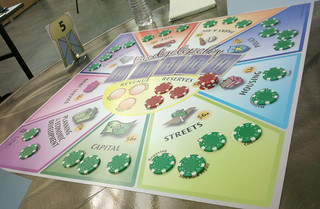Chapel Hill's forthcoming comprehensive plan is supposed to accomplish many things, one of which is to guide Town staff as the transition to from an incremental budgeting system to one that is priority-driven. Since the Town is beginning to use priority budgeting this year, I have been unsure as to how this will work. Last week, as part of Chapel Hill 2020, the Town hosted a budget simulation exercise called Budgetopolis to learn more about value-based budgeting. This exercise, facilitated by staff from the UNC School of Government, was held at the NC Botanical Gardens. Because of my role as an advisory board chair, I was invited to participate.
The session, which was limited to 60 people, included two council members, quite a few Town employees, advisory board members, and several people from outside organizations (Local Government Federal Credit Union had at least two employees present). It began with a presentation by School of Government instructor (and former Asheville City Manager) Doug Bean about how budgeting works in North Carolina. As a long-time activist in local government, I found the information rather basic, but it might have be en helpful to any newcomers to budgeting process. However, I think most of the people in the room had more experience with budgeting that I do.
The second half of the session was spent on the simulation exercise. At the beginning of the afternoon, we were all assigned seats at small, numbered tables. Each table represented a city. The people at each table were instructed to elect a mayor, to help facilitate discussion, an a clerk, who wrote down the actions of the group at the end of each round. We were then given an envelope with ten cards in it. Each card represented a value (such as "Clean and Green Environment" and "Safe and Secure Community"), and the table had to select five values to represent our city. Those values were supposed to guide our budgeting process.
Once the game began, we used a list of possible service cuts (represented by green poker chips on the game board) to decide how to balance our budget. We could also raise taxes or draw from our reserves (represented by red poker chips). Each chip was the equivalent of one million dollars. The first round of play began with a relatively small budget cut ($3 million dollars), and each subsequent round demanded more cuts. We recorded our decisions on a piece of paper, which was given to a School of Government staff member at the front of the room. She then inputed the data into a spreadsheet that was projected onto the wall. In the final round of play, each city was given a budget surplus, and we were able to choose to restore any of the services we cut, lower taxes, or return the money to our reserves.
My table did not have much trouble meeting a consensus during each round. I think part of that had to do with our similar budgeting philosophy, and the rest was because we had the advantage of the Town Manager and the Town's Director of Business Management at our table, who have years of experience with developing budgets. Some groups took much longer, and at one table, several members got up and left halfway through the exercise and never came back. Overall, our available budget choices were kind of simplistic, but they got the point across about the type of cuts that need to be made in a tight budget year. One of my favorite parts of the exercise was looking at the spreadsheet on the wall, because it was interesting to see the choices that the other groups made. In the end, my table was the only one to keep from raising taxes, though we had to draw from our reserves during one round. At the end, we replaced the reserve money and restored one of the services we cut.
I thought Budgetopolis was an interesting experience, but am unsure if it was helpful to our group. While I enjoyed getting to try to balance a budget, I think most of the atendees were staff who have past experience with budgeting. I also do not understand why the exercise was not open to the public. It might have been due to lack of space or materials, because the game kits were rather extensive, and the room we were in was not very large. However, I think that this type of exercise would be most helpful to regular citizens who are interested in how budgeting works. It would be neat to see the Town work with the School of Government to develop a version of the game that could be used with larger groups. The information and experience was useful; I'm just not sure that the audience in attendance were the ones that needed the instruction.
Issues:




Comments
Thanks, Erin!
Well done post. Thanks! Will be interesting to see how much changes from this process.
interesting... were cutting programs the only option?
Nice report. Was there any opportunity for the participants to discuss strategic issues - such as shared services, or shared facilities -where towns or county and town work together to share buidings or other infrastructure in order to cut costs without cutting services?
How 'about options to streamline/simplify services or eliminating features that are outdated or no longer effective?
Clarifying priorities is a great first step - but cutting programs is only one way to reduce costs.
Improved efficiency, reduced bureaucracy, and restructuring services can go a long way to reduce costs without impacting programs or services.
thanks for the report.
Bonnie Hauser
Yes, there were other options
There were opportunities for streamlining or sharing services in the game. Some of the options for balancing the budget included consolidating emergency services, as well as planning staff. These were done by each individual table, though. The table was considered a self-contained city, and any regional collaboration was made with imaginary partners- not the other tables.It would have been interesting if we had more room for creativity in our budget choices. In this scenario, we could pick from a combination of about twenty preset options. I assume this is because the wanted to keep the game moving without bogging us down in minutiae, but it seemed pretty simplistic.
What if....
Do you think it would have been so easy if you had been given values that you didn't share?
Probably not. I'm glad we
Probably not. I'm glad we got to choose what our values were, because it helped to build consensus about our budget choices.
Values
Erin, do you remember what all 10 of the values cards were?
Value Cards
The five my table chose were:-Affordable and Safe Housing-Safe and Secure Community-Clean and Green Environment-Infrastructure to Support Growth-Nuturing and Family Friendly CityI did a online search because I couldn't remember the specific names of the other five. I found four of them:-Fiscally Conservative Finances-Well-Maintained Streets (which we thought could be covered under infrastructure)-Full Employment-Liveable and Well-Maintained NeighborhoodsThe final one had something to do with cultural vibrancy, but I wasn't able to find the specific phase that was used.If you want to see what the game is like in action, I found a set of photos from a session in Shelby, NC here.
Reason for Leaving
"Some groups took much longer, and at one table, several members got up
and left halfway through the exercise and never came back."FYI, the group that got up and left around 4:15 was comprised of Rosemary Waldorf, Matt Czajkowski and myself (George Cianciolo). It was unfortunate that we had all been assigned to the same table but we had a previously scheduled meeting, that had been re-scheduled several times already, to bring Councilman Czajkowski up to date on the CH2020 process. We were enjoying the game at that point but felt it was more important to deal with the real-life process that we were all engaged in.